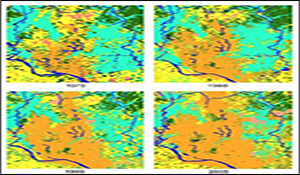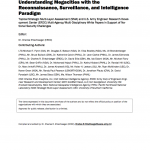Understanding Megacities with the ISR Paradigm

Understanding Megacities with the Reconnaissance, Surveillance, and Intelligence Paradigm.
Author | Editor: Ehlschlaeger, C. (ERDC).
Given the challenges of declining DOD budgets while improving our ability to monitor megacity populations, this white describe many of the issues facing the DOD for phase zero operations and collecting theinformation necessary should conflicts escalate.
The overriding goal of this White Volume is how to best understand the changing population, infrastructure, and environment in complex urban environments so that we can respond to both short‐ and long‐term national security challenges. The SMA research project “Megacity Reconnaissance, Surveillance, and Intelligence Project: Dhaka Pilot” uses the term `Megacity’ in its title to reflect the challenges of under‐ standing rapidly changing urban environments. SMA chose Dhaka, Bangladesh for the case study because Dhaka is one the quintessential urban spaces that traditional DoD socio‐cultural techniques would find most challenging to understand. Dhaka is one of the fastest growing cities in the world, a megacity with no indication that its growth rate will decline.
This White Volume explores issues relevant to understanding urban populations, both today and years from now, and the stability indicators that will help to monitor insecurity and prevent potential crises around the world. While the U.S. Government has long monitored the stability of other regimes, it does not have a long history of extensively monitoring other populations except when U.S. troops are deployed overseas. For example, the South Vietnamese military and the U.S. Army works side‐ by‐side extensively measuring and monitoring populations in rural areas prone to Vietcong activities. This very labor intensive survey was stored in a database man‐ agement system and quantitatively analyzed. It was statistically shown that the col‐ lection and use of this database reduced violence in areas with data collected com‐ pared to similar areas not monitored. Monitoring populations using human terrain teams or U.S. and Partner Nation military units, however, is both risky and labor in‐ tensive. Thus, existing population monitoring in Afghanistan and Iraq cannot be per‐ formed across the entire globe due to their costs. It is necessary to change the way we collect, integrate, and disseminate population information to achieve short‐ and long‐term national security goals.
The White Volume’s authors represent practitioners and researchers with extensive experience in their respective fields. While we were unable to include all the experts desired for this effort, the White Volume contains a broad spectrum of perspectives for better understand urban environments. The chapters are organized from the more theoretical and philosophical to the more technical. The following brief de‐ scription of these papers provides an overview of each chapter, but doesn’t express all the content contained within.
Dr. James Knotwell’s “Megacity Place‐Centric Population Analysis” begins the White Volume with a discussion on the need for cultural understanding in RSI using the “Fundamental Four” cultural descriptors. He points out the Fundamental Four doesn’t account for the “analysis of place”, or how geography affects culture. Dr. Knotwell discusses in detail how socio‐cultural analysis could be improved by better understanding of geographic analysis of place.
Next, Marc Imhoff et al.’s “Evaluating Long‐Term Threats to Environmental Security via Integrated Assessment Modeling of Changes in Climate, Population, Land Use, Energy, and Policy” chapter discusses regional environmental security forecasting energy, water scarcity, and climate changes far into the future.
In the third chapter “Understanding Megacities‐RSI – Dhaka’s Design as an Expres‐ sion of Culture & Politics,” Dr. David Ellis and James Sisco explore the socio‐cultural dynamics of Dhaka, Bangladesh from the community level, mahallas, upwards to better understand instability indicators. The chapter discusses the tension between political, religious, and social aspects of the unplanned megacity.
Douglas Batson’s chapter on land tenure and property rights in megacities discusses rural‐to‐urban migration and the piratical power grabs associated with slum for‐ mations. It examines ungoverned urban spaces and the process of building human security by improving poor peoples’ hold on land. Finally, the chapter discusses three tools that will aid in identifying and understanding who occupies and controls megacity spaces.
In the fifth chapter, “Urban Socio‐Cultural Monitoring with Passive Sensing,” Michael Farry et al. propose that passive sensors located in difficult to assess urban envi‐ ronments will provide actionable intelligence in local or tactical situations. The au‐ thors analyze how various measurable social signals can be applied to PMESII vari‐ ables. The use of small sensors, while potentially problematic if used in phase zero environments, could provide valuable information in ungoverned urban spaces when supported by partner nation governments.
While other chapters in this White Volume discuss ways to represent populations geographically or culturally, Randy Pearson’s “A Network‐based Approach to Na‐ tional Security” raises the challenges of understanding illicit financial networks. Pearson discusses the trans‐dimensionality of illicit networks, and the difficulty of representing this information for DOD operational planning. The complexity of fi‐ nancial networks is not an uncommon one for socio‐cultural analysis. Socio‐cultural systems cannot be easily represented in any of the traditional quantitative visualiza‐ tion methodologies (I.e., thematic maps, topographic maps, networks) because the number of dimensions of socio‐cultural factors is greater than what can easily be readily seen.
In Chapter Seven, “Evaluating Slum Severity from Remote Sensing Imagery,” Dr. Karen Owen discusses original research demonstrating remote sensing techniques that will help identify neighborhood‐scale socio‐cultural information in urban areas, especially economic variability. While the techniques require calibration for each megacity, the research provides excellent direction for experienced remote sensing professionals.
Chapter Eight, “Modeling the Discourse of Megacities: Assessing Remote Populations in the Non‐Western Worlds,” Dr. Kalev H. Leetaru & Dr. Charles Ehlschlaeger discuss the ramifications of collecting information from the internet in order to understand megacities. They argue that while megacities have unique geographic and social characteristics, the tools and techniques for understanding communication remain the same but that additional foundational information will ease the difficulty of monitoring urban areas in the RSI paradigm.
Chapter Nine, “How Semi‐Automated Analysis of Satellite Imagery Can Provide Quick Turn‐Around Economic and Environmentally Relevant Answers to Large Scale Questions”, by Ms. Ida Eslami et al., provides a technical discussion on re‐ search that can greatly benefit the RSI paradigm. The goal of their research is to de‐ velop techniques for taking satellite imagery and processing it to actionable infor‐ mation. Their technique mainly uses MODIS satellite products updated every 16 days in order to monitor changes and trends over time. Possible socio‐cultural ap‐ plications include urbanization, crop abundance & predicted yields, and the availa‐ bility of natural resources. Given the challenges of monitoring megacities around the world in phase zero, automated techniques will be necessary to derive information from the copious amounts of data collected from satellites and the internet.
The final chapter, “UrbanSim: Using Social Simulation to Train for Stability Opera‐ tions,” Ryan McAlinden et al. discuss modeling urban environments for training. Social and cultural modeling plays a critical role in advancing our situational under‐ standing of these complex, interwoven environs. Academia, government and indus‐ try all continue to make advancements in developing accurate models of human be‐ havior, though significant challenges still remain. These challenges are presented in the context of an existing training application for teaching Battalion commanders how to successfully navigate complex, multifaceted missions where the populace is the cornerstone to success.
Contributing Authors
LTG Michael T. Flynn (DIA), Mr. Douglas E. Batson (NGA), Dr. Eliza Bradley (NGA), Ms. Jill Brandenberger (PNNL), Mr. Bruce Bullock (CRA), Dr. Katherine Calvin (PNNL), Dr. Leon Clarke (PNNL), Dr. James Edmonds (PNNL), Dr. Charles R. Ehlschlaeger (ERDC), Dr. David Ellis (GBH), Ms. Ida Eslami (NGA), Mr. Michael Farry (CRA), Mr. Sean Griffin (NGA), Dr. Mohamad Hejazi (PNNL), Dr. Kathy Hibbard (PNNL), Dr. Randall Hill (USC), Dr. Marc Imhoff (PNNL), Dr. James Knotwell (KG), Mr. Kalev H. Leetaru (GU), Mr. Ryan McAlinden (USC), Dr. Karen Owen (NGA), Mr. Randy Paul Pearson (USNORTHCOM), Dr. Jonathan Pfautz (CRA), Dr. David Pynadath (USC), Mr. James Sisco (GBH), Ms. Allison Thomson (PNNL)

Comments